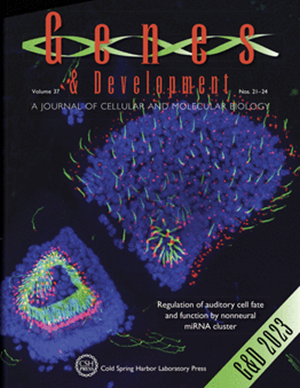MRN-CtIP, EXO1和DNA2-WRN /BLM在parpi处理的细胞中双向作用,在没有链切割的情况下加工DNA间隙
IF 7.7
1区 生物学
Q1 CELL BIOLOGY
引用次数: 0
摘要
单链DNA (ssDNA)缺口影响基因组稳定性和PARP抑制剂(PARPi)敏感性,特别是在brca1 /2缺陷肿瘤中。利用单分子DNA纤维分析、电子显微镜和生化方法,我们发现MRN、CtIP、EXO1和DNA2-WRN /BLM通过不同于它们在DNA末端的作用机制来切除ssDNA间隙。MRN利用其pctip刺激的外切酶活性,在3 ‘ -5 ’方向上切除ssDNA间隙。与DNA末端不同,MRN不使用其核内溶活性来切割间隙两侧的5 '端链或ssDNA。EXO1和DNA2-WRN /BLM特异性地切除了与MRN-CtIP无关的缺口的5 '端。这种切除过程改变了brca1精通细胞和brca1缺陷细胞的ssDNA间隙修复动力学。在使用PARPis处理的brca1缺陷细胞中,过度切除导致更大的ssDNA间隙,阻碍了它们的修复,并且由于ssDNA间隙与DNA复制叉碰撞而导致后续细胞周期阶段的DNA断裂。这些发现拓宽了我们对人类核酸酶在DNA代谢中的作用的理解,并对定义brca缺陷肿瘤中驱动PARPi敏感性的机制具有重要意义。本文章由计算机程序翻译,如有差异,请以英文原文为准。
MRN–CtIP, EXO1, and DNA2–WRN/BLM act bidirectionally to process DNA gaps in PARPi-treated cells without strand cleavage
Single-stranded DNA (ssDNA) gaps impact genome stability and PARP inhibitor (PARPi) sensitivity, especially in BRCA1/2-deficient tumors. Using single-molecule DNA fiber analysis, electron microscopy, and biochemical methods, we found that MRN, CtIP, EXO1, and DNA2–WRN/BLM resect ssDNA gaps through a mechanism different from their actions at DNA ends. MRN resects ssDNA gaps in the 3′-to-5′ direction using its pCtIP-stimulated exonuclease activity. Unlike at DNA ends, MRN does not use its endonucleolytic activity to cleave the 5′-terminated strand flanking the gap or the ssDNA. EXO1 and DNA2–WRN/BLM specifically resect the 5′ end of the gap independent of MRN–CtIP. This resection process alters ssDNA gap repair kinetics in BRCA1-proficient and -deficient cells. In BRCA1-deficient cells treated with PARPis, excessive resection results in larger ssDNA gaps, hindering their repair and leading to DNA breaks in subsequent cell cycle stages due to ssDNA gaps colliding with DNA replication forks. These findings broaden our understanding of the role of human nucleases in DNA metabolism and have significant implications for defining the mechanisms driving PARPi sensitivity in BRCA-deficient tumors.
求助全文
通过发布文献求助,成功后即可免费获取论文全文。
去求助
来源期刊

Genes & development
生物-发育生物学
CiteScore
17.50
自引率
1.90%
发文量
71
审稿时长
3-6 weeks
期刊介绍:
Genes & Development is a research journal published in association with The Genetics Society. It publishes high-quality research papers in the areas of molecular biology, molecular genetics, and related fields. The journal features various research formats including Research papers, short Research Communications, and Resource/Methodology papers.
Genes & Development has gained recognition and is considered as one of the Top Five Research Journals in the field of Molecular Biology and Genetics. It has an impressive Impact Factor of 12.89. The journal is ranked #2 among Developmental Biology research journals, #5 in Genetics and Heredity, and is among the Top 20 in Cell Biology (according to ISI Journal Citation Reports®, 2021).
 求助内容:
求助内容: 应助结果提醒方式:
应助结果提醒方式:


